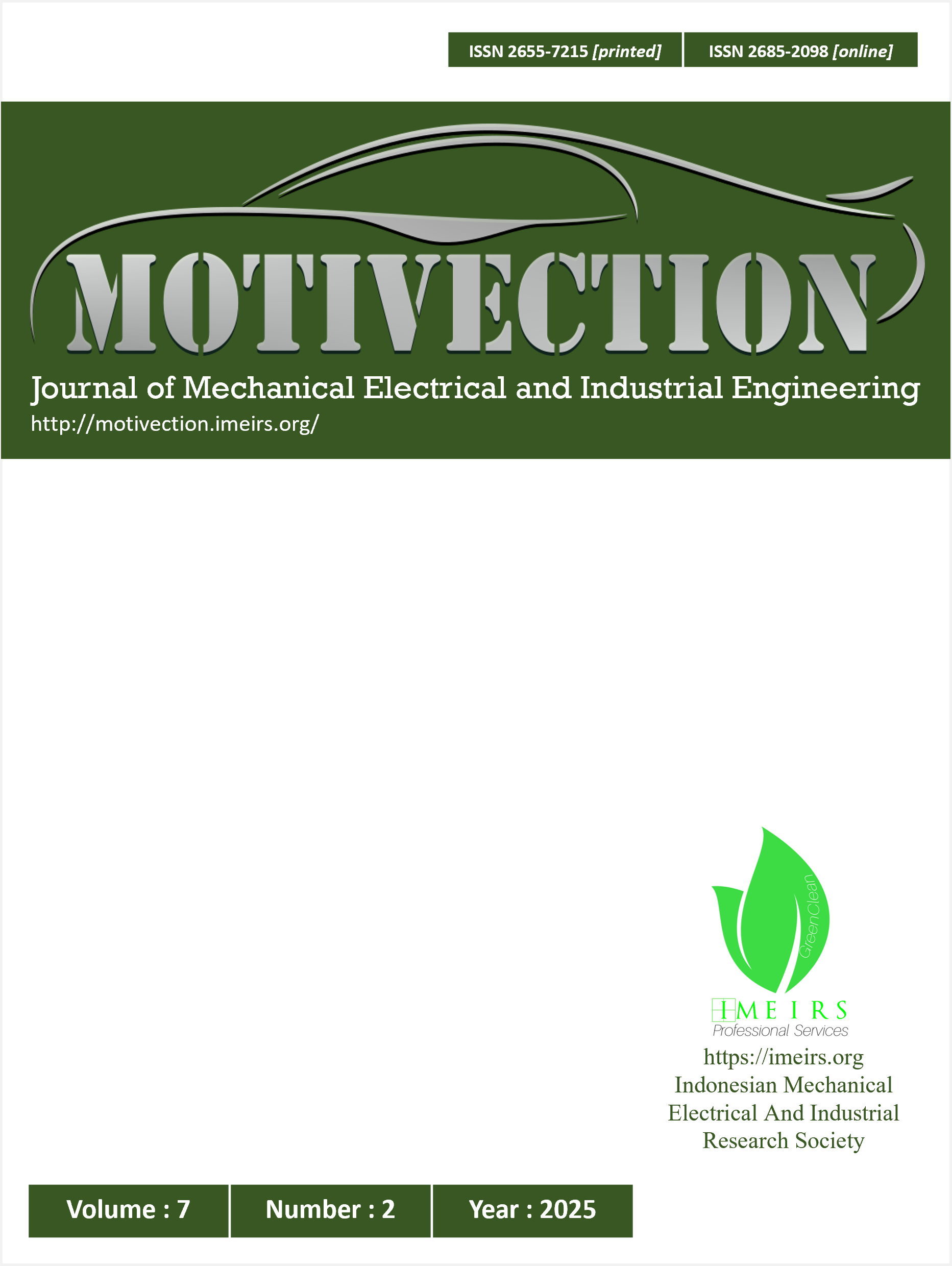Design of Warehouse Management Information System (Case Study: PT Total Teknologi Rekacipta)
##plugins.themes.academic_pro.article.main##
Abstract
This study aims to design a warehouse management information system by implementing the 5S method to address the stock checking and item arrangement disorganization at PT Total Teknologi Rekacipta. Currently, the company conducts stock recording manually, resulting in poorly arranged items, ungrouped spare parts, lengthy stock-checking processes, and frequent data duplication. The 5S method (Seiri, Seiton, Seiso, Seiketsu, and Shitsuke) is applied to organize the warehouse area, supported by developing a web-based inventory information system using the Waterfall methodology. The system is developed using PHP and MySQL, featuring data input, storage location tracking, and photo documentation. Black box testing results show that all functional system requirements are met. This system enhances stock management efficiency and accelerates company decision-making processes. The implementation reduced stock checking time from 1–2 days to less than 1 minute and eliminated data duplication. While 5S and web-based inventory are well-known approaches, this study contributes a practical implementation model by combining warehouse organization through 5S as a preparatory step before digitalization. This stepwise approach can serve as a reference for small and medium enterprises seeking to improve their physical warehouse management and digital stock control practices.
##plugins.themes.academic_pro.article.details##

This work is licensed under a Creative Commons Attribution 4.0 International License.
Copyright (c): Difana Meilani, Hadyan Zada Fitra (2025)References
[2] T. R. Biswas, M. Z. Hossain, and P. U. Comite, "Role of Management Information Systems in Enhancing Decision-Making in Large-Scale Organizations," Pacific J. Bus. Innov. Strategy., vol. 1, no. 1, pp. 5–18, 2024.
[3] O. Ayomide, D. O. Abosede, A. K. Gabriel, and O. Timothy, "A Review of Existing Inventory Management Systems," Int. J. Res. Eng. Sci., vol. 12, no. 9, pp. 40–50, 2024.
[4] M. Javaid, A. Haleem, R. P. Singh, and R. Suman, "Enabling flexible manufacturing system (FMS) through the applications of industry 4.0 technologies," Internet Things Cyber-Physical Syst., vol. 2, no. April, pp. 49–62, 2022, doi: 10.1016/j.iotcps.2022.05.005.
[5] M. Awais Javed, M. Alam, M. Ariful Alam, R. Islam, and M. N. Ahsan, "Design and Implementation of Office Automation System based on Web Service Framework and Data Mining Techniques," J. Data Anal. Inf. Process., vol. 12, pp. 523–543, 2024, doi: 10.2991/icmemtc-16.2016.99.
[6] B. Marnova and T. M. Tung, "Analysis of the layout of the Dangerous and Toxic Goods (B3) warehouse using the 5S method (Seiri, Seiton, Seiso, Seiketsu, and Shitsuke) on PT Mitra Agung Sejati," Sinergi Int. J. Logist., vol. 1, no. 1, pp. 42–62, 2023, doi: 10.61194/sijl.v1i1.14.
[7] Hamed Taherdoost, "An Overview of Trends in Information Systems: Emerging Technologies that Transform the Information Technology Industry," Cloud Comput. Data Sci., vol. 4, no. 1, pp. 1–16, 2022, doi: 10.37256/ccds.4120231653.
[8] K. C. Laudon and J. P. Laudon, Manajemen Information System: Managing the Digital Firm. 2014.
[9] D. Bourgeois, "Chapter 6: Information Systems Security," Inf. Syst. Bus. Beyond, pp. 1–167, 2014, [Online]. Available: http://www.saylor.org/courses/bus206
[10] J. Rumbaugh, I. Jacobson, and G. Booch, The Unified Modeling Language Reference Manual, vol. 53, no. 9. 2021.
[11] G. Booch, J. Rumbaugh, and I. Jacobson, The Unified Modelling Language User Guide. 1999.
[12] S. Pargaonkar, "A Comprehensive Research Analysis of Software Development Life Cycle (SDLC) Agile & Waterfall Model Advantages, Disadvantages, and Application Suitability in Software Quality Engineering," Int. J. Sci. Res. Publ., vol. 13, no. 8, pp. 120–124, 2023, doi: 10.29322/ijsrp.13.08.2023.p14015.
[13] M. Gaborov et al., "Comparative analysis of agile and traditional methodologies in IT project management," J. Appl. Tech. Educ. Sci. jATES, vol. 11, no. 4, pp. 1–24, 2021, [Online]. Available: https://doi.org/10.24368/jates.v11i4.279http://jates.org
[14] N. Murthy MR, "Comparative Analysis of Waterfall and Agile Software Development Models: A Comprehensive Review," Int. J. Sci. Res., vol. 13, no. 1, pp. 580–581, 2024, doi: 10.21275/sr24105103239.
[15] T. Thesing, C. Feldmann, and M. Burchardt, "Agile versus Waterfall Project Management: Decision model for selecting the appropriate approach to a project," Procedia Comput. Sci., vol. 181, pp. 746–756, 2021, doi: 10.1016/j.procs.2021.01.227.
[16] W. Wiguna, B. Susanto, and M. Tukiran, "Application of 5S (Seiri, Seiton, Seiso, Seiketsu, Shitsuke) in the Mobile Shop Work Area As an Effort To Increase Work Productivity (Case Study At Pt Xyz)," Int. J. Econ. Educ. Entrep., vol. 2, no. 3, pp. 726–739, 2022, doi: 10.53067/ije3.v2i3.112.
[17] B. Chandrayan, A. K. Solanki, and R. Sharma, "Study of 5S lean technique: A review paper," Int. J. Product. Qual. Manag., vol. 26, no. 4, pp. 469–491, 2019, doi: 10.1504/IJPQM.2019.099625.
[18] Y. A. Rizky, K. Khuzaini, and S. Shadiq, "Decluttering for enhanced workplace performance: The 5S solution," J. Inov. Ekon., vol. 8, no. 02, pp. 69–82, 2023, doi: 10.22219/jiko.v8i02.26916.
[19] K. Gupta, "A Review on Implementation of 5S for Workplace Management," J. Appl. Res. Ind. Eng., vol. 9, no. 3, pp. 323–330, 2022, doi: 10.22105/jarie.2021.292741.1347.
[20] R. Wolniak, "The Usage Of 5S In Industry 4 . 0 Conditions," Manag. Qual., vol. 6, no. 4, pp. 180–200, 2025.

